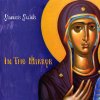A Collection of Iconographic Essays and Illustrations
By Fr. Stamatis Skliris
The Serbian Orthodox Diocese of Western America is pleased to announce the publication of an outstanding book by Fr. Stamatis Skliris, a disciple of the great twentieth-century theologians Archimandrite Justin Popovich and Bishop Athanasius Yevtich. Fr. Stamatis is a parish priest in Athens and is renowned as an iconographer and as a writer and lecturer on Byzantine iconography.
In the Mirror is the second of a planned collection of works of contemporary theologians. It is an anthology of Fr. Stamatis’ articles which have appeared in Greek and Serbian. In it, he combines adherence to the teachings of the Church Fathers with a vibrant expression of faith through the experience of Christ in the Church. The book is adorned with more than 200 striking icons and illustrations by Fr. Stamatis.
Fr. Stamatis’ contribution to modern art (both Church art, and art in general) through his painting and iconography is already a generally established fact. Focusing on themes central to patristic Christology and Anthropology, the book reveals the ultimate purpose of the icon. Fr. Stamatis speaks of how, through the reality of the Incarnation of the Invisible God, we have been given the possibility of Christian iconography, iconology and icon veneration.
Upon observing Fr. Stamatis’ artwork, we see that he manages to link the graphic and the chromatic elements harmoniously and with rare originality, thus anticipating with his drawing and coloring a wondrous world, God’s world of love and light. With regard to the graphic element, by the mobility and expressiveness of his images, with the open, childlike looks in their eyes—through his excellent knowledge of anatomy (being a medical doctor) and of psychology (being a priest and a spiritual father)—Fr. Stamatis overcomes the immobility and inertia of fallen human nature through a movement of reaching out, which is the feat of loving and of an eager progress toward Christ. As far as coloration is concerned, by a combination of color (warm-cold, complementary), by a gradation of tones, and by a multitude of vibrating shades brought on by the brush—employing the best solutions from the history of the art of painting (Byzantine, impressionist, cubistic, abstract, surrealist, etc.)—and in doing all this, illuminating everything by light, Fr. Stamatis anticipates the coloration of Paradise, the coloration of “a new Heaven and a new Earth” (Rev. 21:1). In addition to this, he also offers a thematic contribution: he does not overlook emphasizing the historic, tragic element (agony, suffering, wounds, and pain) in the images of saints and martyrs depicted in his works, and especially in his most recent creations, which are, nevertheless, illuminated by the Light which overcomes the world and history.
Contents:
- A Questioning Gaze by Metropolitan John (Zizioulas) of Pergamon
- Aesthetic Light and Ontological Light in the Art of Painting
- The Pedagogical Potential of Byzantine Art
- From Portrait to Icon
- The Person of Christ and the Style of Icons
- The Icons of Fr. Stamatis Skliris by Metropolitan John (Zizioulas) of Pergamon
- An Interpretation of Hellenism Based on the Conduction of Light
- Shading and Psychology in the Wall Paintings of Saint Nikolaos Orphanos
- Andrei Rublev—The Saint of Russian Iconography
- The Icon and the Ultimate State of Existence by Bishop Maxim (Vasiljevic) of the Serbian Orthodox Diocese of Western America





